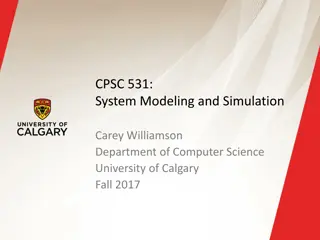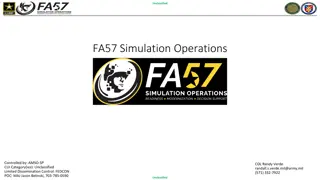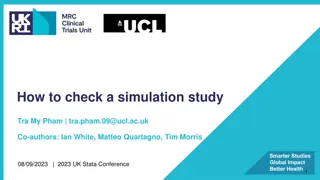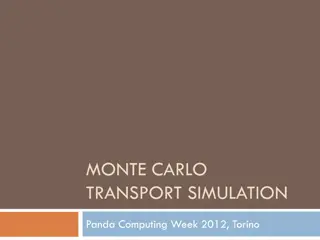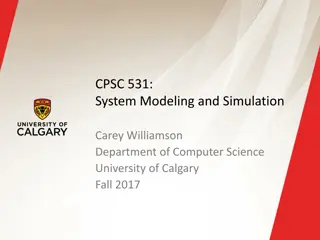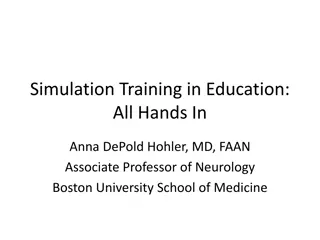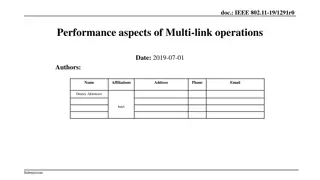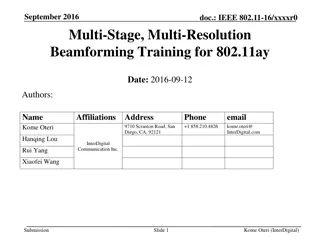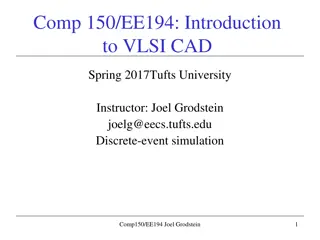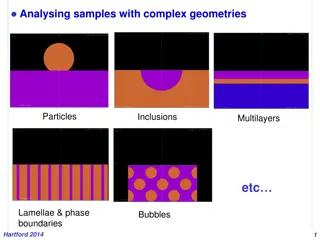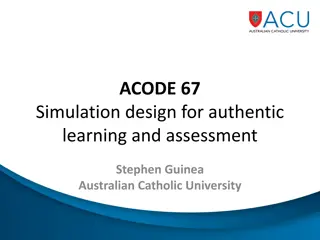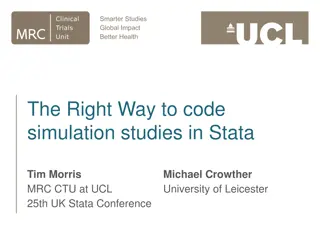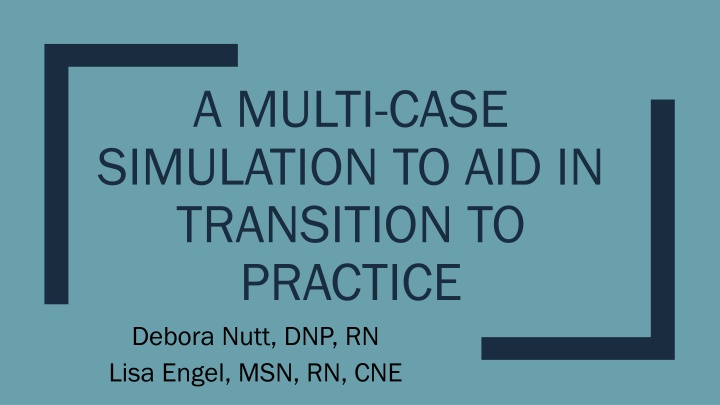
Enhancing Nursing Leadership Skills through Multi-Case Simulation
Explore how a multi-case simulation can improve novice nurses' transition to practice by enhancing leadership skills. This study focuses on addressing the challenges novice nurses face in a chaotic hospital environment and aims to increase their confidence in independent nursing care through simulated learning activities. Goals include evaluating students' perceived confidence and assessing the impact of simulation on essential skills like delegation, conflict management, and critical thinking.
Download Presentation

Please find below an Image/Link to download the presentation.
The content on the website is provided AS IS for your information and personal use only. It may not be sold, licensed, or shared on other websites without obtaining consent from the author. If you encounter any issues during the download, it is possible that the publisher has removed the file from their server.
You are allowed to download the files provided on this website for personal or commercial use, subject to the condition that they are used lawfully. All files are the property of their respective owners.
The content on the website is provided AS IS for your information and personal use only. It may not be sold, licensed, or shared on other websites without obtaining consent from the author.
E N D
Presentation Transcript
A MULTI-CASE SIMULATION TO AID IN TRANSITION TO PRACTICE Debora Nutt, DNP, RN Lisa Engel, MSN, RN, CNE
Introduction Complex, chaotic hospital environment Novice nurses need leadership skills (Marquis & Huston, 2017) Novice nurses feel unprepared to handle difficult challenging clinical environment (Radovich et al, 2011) Retention rate for new RN s 83% which means 17% leave their jobs during first year (Blegen et al, 2017; Kovner et al 2014)
Transformational Proposal to implement a multi-case simulation Final semester course (Leadership) Change from a group of students caring for 1 patient to a group of students would care for multiple patients Use cases from content taught in previous medical-surgical courses No prep the night before (nurses do not prep before work) Culminating simulation experience for students Planning: CC, Simulation coordinator, graduate student Initial Pilot group of 7 students fall 2015
Purpose & Goals To define how simulated learning simulations can enhance leadership skills and address lack of transition to nursing practice Goals: conduct an evaluation of current students to determine perceived confidence with providing nursing care in an independent manner determine if simulation enhanced leadership skills needed to nursing practice such as delegation, conflict management, and critical thinking
Methods Seniors students in leadership participated in 2 spaced simulated activities utilizing 4 patients Simulation included 2 standardized (live) patients and 2 high fidelity manniquins Sign confidentiality and video recording consents Leadership Simulation objectives and orientation were shared prior to simulation Pre Pre- -briefing briefing: review of charts, choose a charge nurse discuss role of charge nurse, development of SOAP for each patient, discussion of each patient with priority plans Simulation Simulation: brief simulation update to time, pyxis, bedside report from previous nurse, simulation De De- -briefing: briefing: review and discussion of simulation Documentation: Documentation: update & revise SOAP with final prioritization of problems, complete unfinished documentation (assessment, nurses notes, MAR, new orders)
Methods continued Simulation 2: Simulation 2: Occurs week 10-12 of semester same 4 patients but 48 hours later in care Staff and family conflicts Skills: environmental assessment, patient assessment, communication, PRN medications, clinical skills: IV start, foley insertion, NG tube insertion, trach care and suctioning Simulation 1: Simulation 1: occurs week 5 & 6 of semester 4 patients with medical surgical problems conflicts focus on patient, family and/or chart conflicts Skills: environmental assessment, patient assessment, communication, am medication administration
Methods continued IRB consent obtained from University IRB committee Students completed simulation evaluation after each simulation Students watched simulation 1 and completed self-evaluation then one on one debrief with course coordinator Consent obtained after 2ndsimulation to avoid any Hawthorne effect No identifying data collected with evaluations
Data Collection & analysis Data collected over 5 semester spring 2016 to spring 2018 Researcher-developed questionnaire to address Leadership components and transition to practice based on NLN simulation evaluation Likert scale questions reflecting teamwork, critical thinking, assessment, transition to practice, conflict resolution, communication, confidence in performing skills, delegation, areas of personal improvement, time to reevaluate care Readiness to practice nursing ranked on a 1-10 scale Questionnaire peer reviewed prior to implementation
Students Evaluations after Simulation 2 End of Semester All Combined (Spring 2016 to Spring 2018) Strongly Agree Results Metrics Agree Neutral Disagree Strongly Disagree Did you feel the simulation process enhanced your ability to work as a team? (N = 121) 80.2% (97) 19.0% (23) 0.8% (1) 0 0 Do you feel the simulation process enhanced your critical thinking skills? (N=121) 77.7% (94) 22.3% (27) 0 0 0 Do you feel the simulation process enhanced your assessment skills? (N=121) 62.0% (75) 36.4% (44) 1.7% (2) 0 0 Do you feel the simulation process will assist you in transitioning into nursing practice? (N=120) 77.4% (185) 20.5% (49) 2.1% (5) 0 0 Do you feel the simulation process allowed you to practice handling conflict resolution? (N=121) 76.0% (92) 17.4% (21) 5.0% (6) 0.8% (1) 0.8% (1) Do you feel the simulation process enhanced your communication skills? (N=121) 81.0% (98) 18.2% (58) 0.8% (1) 0 0 Do you feel the simulation process enhanced your confidence in nursing skills? (N=121) 67.8% (82) 25.6% (31) 4.2% (5) 0.8% (1) 0.8% (1) Do you feel the simulation process enhanced your delegation skills? (N=121) 62.0% (75) 28.9% (35) 9.1% (11) 0 0 Do you feel the simulation process allowed you to see areas of personal improvement? (N=121) 80.2% (97) 19.0% (23) 0.8% (1) 0 0 Do you feel the post-simulation allowed you to assess and reevaluate actions taken during the simulation process? (N=121) 76.9% (93) 22.3% (27) 0.8% (1) 0 0
Student Preparation to Practice Results & Metrics: conflicts and preparation for career All Combined (Spring 2016 through Spring 2018) All Combined (Spring 2016 through Spring 2018) Likert scale (1 to 10) Likert scale (1 to 10) N=121 N=121 Mean Median Std. Deviation After participating in the After participating in the competency simulation, how competency simulation, how confident do you feel with confident do you feel with handling conflicts? handling conflicts? 8.179 8 0.9411 After participating in After participating in simulation and competency, simulation and competency, how prepared do you feel for how prepared do you feel for beginning your nursing career? beginning your nursing career? 8.171 8 1.2611
Comparison of Means Results & Metrics Comparison of Means Skill Skill Mean Mean SD SD t t df df sig (2 sig (2- -tailed) tailed) Assessment skills #1 Assessment skills #1 4.39 .654 -2.726 238 .007 Assessment skills #2 Assessment skills #2 4.6 .524 Skills confidence #1 Skills confidence #1 4.31 .663 -3.263 236 .001 Skills confidence #2 Skills confidence #2 4.6 .691 Delegation skills #1 Delegation skills #1 4.26 .685 -3.062 237 .002 Delegation skills #2 Delegation skills #2 4.53 .659
Barriers/Obstacles Takes many faculty members and volunteers Time and coordination to run 3 groups of students in a day Coordination of simulation lab with other courses Simulation realistic and stress involved which students are told about ahead of time Adaptations to prepare for simulation with clinical orientation Changes to debriefing and included 1-on-1 debriefing with course coordinator
Discussion Students viewed the simulation as helpful, beneficial, and realistic Students liked being able to work more independently but have a peer resource with charge nurse Students had opportunity to self-identify areas to improve Between 1st & 2nd simulation student evaluation of assessment skills, delegation skills, and confidence improved Compared students preference for simulated (live) patients to high-fidelity mannequin: 52% preferred live simulated patients, 28.1 % benefited from both, and only 14% preferred working with high-fidelity mannequins. Need to do a cost analysis.
References Blegen, M. A., Spector, N., Lynn, M. R., Barnsteiner, J., & Ulrich, B. T. (2017). Newly licensed RN retention: Hospital and nurse characteristics. The Journal of Nursing Administration, 47(10), 508-514. doi: 10.1097/NNA.0000000000000523 IBM. (2013). IBM SPSS Statistics [computer software]. IBM Corporation, Armonk, NY. Kovner, C. T., Brewer, C. S., Fatehi, F., & Jun, J. (2014). What does nurse turnover rate mean and what is the rate? Policy, Politics, & Nursing Practice, 15(3-4), 7=64-71. doi: 10.1177/1527154414547953 Marquix, B. L., & Huston, C. J. (2017). Leadership roles and management functions in nursing. (9th ed). Philadelphia, PA. Wolters Kluwer/Lippincott Williams & Wilkins. Radovich, P., Palaganas, J., Kiemeney, J., Strother, B., Bruneau, B., & Hamilton, L. (2011). Best practices in critical care: Enhancing leadership orientation through simulation. Critical Care Nurse, 31(5), 58-63. doi: 10.4037/ccn2011463

